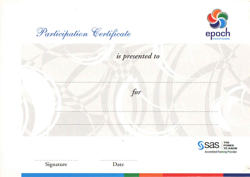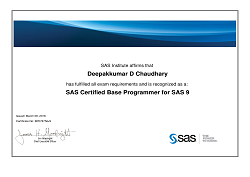- Home
- Base SAS Certification Course (upto 50% Discount)
Base SAS Certification Course (upto 50% Discount)
This course is for users who want to learn how to write SAS programs. It is the entry point to learning SAS programming and is a prerequisite to many other SAS courses. Online Training ( Live Instructor Led Training Program) Classroom Training Upto 50% Discount
Power up your staff’s skills and boost your business
Course Description
Build a strong SAS programming foundation to manipulate your data, perform complex queries and simple analyses, and generate reports. Gain the knowledge needed to become certified as a Base SAS programmer.
About Program
The schedule of events displayed on this page are for full-time program registration. If interested in part-time programs, please contact SAS India.
This course is for users who want to learn how to write SAS programs. It is the entry point to learning SAS programming and is a prerequisite to many other SAS courses. This course helps you prepare you for the following certification exam(s): SAS Base Programming Exam for SAS 9. Candidates for the SAS Base Programmer for SAS 9 exam should be familiar with enhancements and new functionality that are available in SAS 9.4
Format of Training
Live Web Classroom
Training is Led by an expert instructor live online using live web training platform, and this are not pre recorded lectures. Trainer can virtually look over your shoulder. Discuss, share, exchange ideas with students from different countries.
Taste of Live Web - is a perfect platform for indivudals who fear online training. SAS® gives an opportunity to all the registrants to have a closer look at different courses given below with a blend of Online Learning.
All the benefits of the classroom without the travel:
Classroom training options include courses offered in our regional training centers or via our Live Web classroom.
Taught by certified instructors at High-Tech facilities across the country:
- A SAS expert at your side.
- Focused learning away from the office
- Networking opportunities
- State-of-the-art facilities
- Electronic course notes downloadable to your device and permission to print
- Business Knowledge Series: in-depth courses on the latest business topics
- We offer Connected Classes! Watch for courses in Cary, New York, Arlington, Dallas and San Francisco that connect remote students via our Live Web classroom.
Self Paced Learning Platform
SAS e-learning courses are online, hands-on tutorials that you can access whenever and wherever is convenient for you – satisfaction guaranteed. All you need is an internet connection. With e-learning from SAS, you can:
- Train when and where you want.
- Learn at your own pace.
- Access the same content as our instructor-based courses, only optimized for self-study.
- Earn a certificate of completion.
- Benefit from courses created by SAS experts.
Free Training e-learning subscription - please connect with us
Get a quick, easy start with SAS® online training – or expand your learning without spending a dime.
Prerequisite
Before attending this course, you should have experience using computer software. Specifically, you should be able to
- Understand file structures and system commands on your operating systems
- Access data files on your operating systems.
No prior SAS experience is needed. If you do not feel comfortable with the prerequisites or are new to programming and think that the pace of this course might be too demanding, you can take the SAS Programming Introduction: Basic Concepts course before attending this course.
Training Features
- Training
- Course material
- One attempt of Global certification worth $180
48 hours of Instructor-led Classes.
- Classroom: 6 Days/48 Hrs
- Live Web Classroom: 12 half-day session(s)
- e-Learning: 24 Hr/180 Day License (Free)
Course includes embedded practice content for strenthening programming skills.
One attempt of Global certification worth $180
The perfect starting point for those interested in a career as a SAS® professional. Successful candidates should have experience in programming and data management using SAS®9.
Validate your skills. Stand out.
- Earn recognition for your knowledge.
- Increase your value to your employer.
- Enhance your credibility as a SAS professional.
- Get a digital badge you can share.
Course Curriculum
Introduction
- overview of SAS Foundation
- course logistics
- course data files
SAS Programs
- introduction to SAS programs
- submitting a SAS program
- SAS program syntax
Accessing Data
- examining SAS data sets
- accessing SAS libraries
Producing Detail Reports
- subsetting report data
- sorting and grouping report data
- enhancing reports
Formatting Data Values
- using SAS formats
- creating user-defined formats
Reading SAS Data Sets
- reading a SAS data set
- customizing a SAS data set
Reading Spreadsheet and Database Data
- reading spreadsheet data
- reading database data
Reading Raw Data Files
- introduction to reading raw data files
- reading standard delimited data
- reading nonstandard delimited data
- handling missing data
Manipulating Data
- concatenating data sets
- merging data sets one-to-one
- merging data sets one-to-many
- merging data sets with nonmatches
Combining Data Sets
- SAS resources
- next steps
Prerequisite Basic Concepts
- discussing descriptive statistics
- discussing inferential statistics
- listing steps for conducting a hypothesis test
- discussing basics of using your SAS software
Getting Started in Enterprise Guide 7.1
- introducing to the SAS Enterprise Guide 7.1 environment
Introduction to Statistics
- discussing fundamental statistical concepts
- examining distributions
- describing categorical data
- constructing confidence intervals
- performing simple tests of hypothesis
Analysis of Variance (ANOVA)
- performing one-way ANOVA
- performing multiple comparisons
- performing two-way ANOVA with and without interactions
Regression
- using exploratory data analysis
- producing correlations
- fitting a simple linear regression model
- understanding the concepts of multiple regression
- building and interpreting models
- describing all regression techniques
- exploring stepwise selection techniques
Regression Diagnostics
- examining residuals
- investigating influential observations and collinearity
Categorical Data Analysis
- describing categorical data
- examining tests for general and linear association
- understanding the concepts of logistic regression and multiple logistic regression
- performing backward elimination with logistic regression
Introduction
- course logistics
- creating course data files
Controlling Input and Output
- writing observations explicitly
- writing to multiple SAS data sets
- selecting variables and observations
Summarizing Data
- creating an accumulating total variable
- accumulating totals for a group of data
Reading Raw Data Files
- reading raw data files with formatted input
- controlling when a record loads
Data Transformations
- manipulating character values
- manipulating numeric values
- converting variable type
Debugging Techniques
- using the PUTLOG statement
Processing Data Iteratively
- DO loop processing
- conditional DO loop processing
- SAS array processing
- using SAS arrays
Restructuring a Data Set
- rotating with the DATA step
Combining SAS Data Sets
- using data manipulation techniques with match-merging
Creating and Maintaining Permanent Formats
- creating permanent formats
Other SAS Languages
- an overview of other languages
- using the SQL procedure
- the SAS macro language
Learning More
- SAS resources
- next steps
The perfect starting point for those interested in a career as a SAS® professional
Successful candidates should have experience in programming and data management using SAS®9 and should be able to:
- Import and export raw data files.
- Manipulate and transform data.
- Combine SAS data sets.
- Create basic detail and summary reports using SAS procedures.
- Identify and correct data, syntax and programming logic errors.
Candidates who earn this credential will have earned a passing score on the SAS® Base Programming for SAS®9 exam.
Exam Content & Pricing
This exam is administered by SAS and Pearson VUE.
- 60-65 multiple-choice and short-answer questions.
(Must achieve score of 70 percent correct to pass) - 110 minutes to complete exam.
- Use exam ID A00-211; required when registering with Pearson VUE.
- This exam is based on SAS 9.4.
Candidates who earn this credential will have earned a passing score on the SAS® Base Programming for SAS®9 exam.
This exam is administered by SAS and Pearson VUE.
- 60-65 multiple-choice and short-answer questions.
(Must achieve score of 70 percent correct to pass) - 110 minutes to complete exam.
- Use exam ID A00-211; required when registering with Pearson VUE.
- This exam is based on SAS 9.4.
Epoch has three faclities approved for conducting exam.
Project
- Using SAS functions
- Conditional processing
- Using the FREQ procedure
- Using the MEANS and UNIVARIATE procedures
- Using the Output Delivery System
Certificate
FAQs
Each exam challenges candidates to apply specific knowledge they have acquired through SAS software training and/or job experience. Computer-based in format, SAS Global Certification exams comprise multiple-choice and/or short-answer questions, depending on the exam. Exams are generally scheduled through Pearson VUE but are also held at various locations around the world on a pre-scheduled basis. Candidates are allotted varying time limits to complete the exam, depending on which exam is taken. Specific exam content and passing criteria are located within each exam. To encourage your feedback, SAS Global Certification exams include a feature that allows candidates to comment on specific test questions. Your opinions are important to us and are a critical component in test development. Additionally, SAS Global Certification requires candidates to accept the terms of the SAS Institute Inc. Certification Program CandidatCancele Agreement before taking a certification exam.
Short-answer questions require you type your answer in a text box, rather than select your answer from four options. Typically, you will provide a numeric answer or a short section of SAS programming code. When entering code, case is ignored, and all variations of SAS syntax that correctly complete the program are accepted as correct.

 Course Description
Course Description About Program
About Program Format of Training
Format of Training Prerequisite
Prerequisite Training Features
Training Features Course Curriculum
Course Curriculum Project
Project Certificate
Certificate FAQs
FAQs Course Fees
Course Fees

 Watch
Watch Contact
Contact


 Find My Path
Find My Path